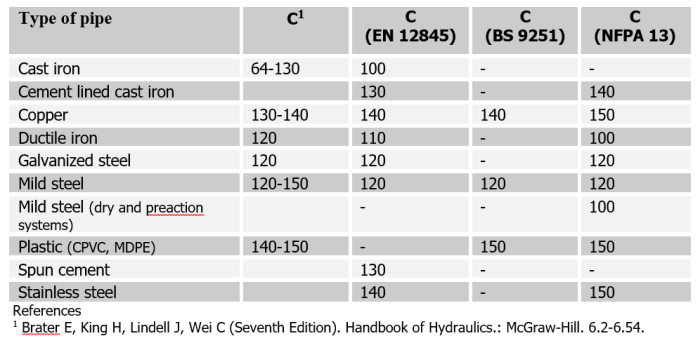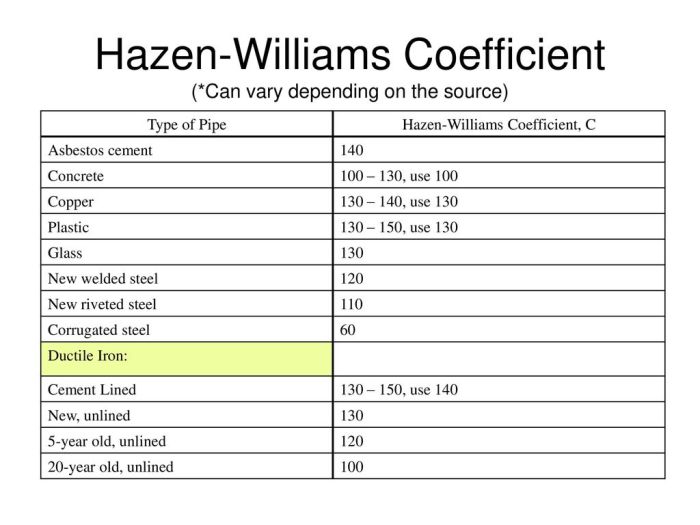Hazen williams coefficient for ductile iron pipe – The Hazen-Williams coefficient plays a pivotal role in the design of ductile iron pipes, influencing flow rates and system performance. This comprehensive guide delves into the definition, formula, factors affecting the coefficient, and its applications in pipe design, providing a thorough understanding of this crucial parameter.
The Hazen-Williams coefficient quantifies the resistance to flow within a pipe, considering factors such as pipe material, age, and condition. By incorporating these variables, engineers can accurately determine the appropriate pipe size and flow capacity for optimal system performance.
1. Definition and Formula

The Hazen-Williams coefficient (C) is a dimensionless parameter used to describe the frictional resistance of fluid flow through pipes. It is widely employed in the design of ductile iron pipes and is defined as:
C = 100
- (Q / (1.852
- A
- R^0.63)))
where:
- Q is the flow rate (cubic feet per second)
- A is the cross-sectional area of the pipe (square feet)
- R is the hydraulic radius (feet)
2. Factors Affecting the Coefficient
The Hazen-Williams coefficient is influenced by several factors, including:
Pipe Material
The material of the pipe, such as ductile iron, steel, or concrete, affects the coefficient due to variations in surface roughness and corrosion resistance.
Age and Condition
As pipes age and accumulate deposits or corrosion, their Hazen-Williams coefficient decreases, leading to increased frictional resistance.
3. Applications in Pipe Design

The Hazen-Williams coefficient plays a crucial role in ductile iron pipe design:
Pipe Sizing
The coefficient is used to determine the appropriate pipe size for a given flow rate and pressure drop.
Flow Capacity, Hazen williams coefficient for ductile iron pipe
The coefficient helps predict the maximum flow rate that a pipe can handle under specific conditions.
4. Comparison with Other Coefficients
Other commonly used coefficients for flow calculations include:
Darcy-Weisbach Coefficient
The Darcy-Weisbach coefficient is a more comprehensive parameter that considers the effects of pipe roughness and Reynolds number.
Chezy Coefficient
The Chezy coefficient is similar to the Hazen-Williams coefficient but uses a different formula and is typically applied to open channels.
5. Case Studies and Examples: Hazen Williams Coefficient For Ductile Iron Pipe

Case studies have demonstrated the successful application of the Hazen-Williams coefficient in ductile iron pipe design:
Example 1
In a water distribution system, the Hazen-Williams coefficient was used to design a ductile iron pipe that could deliver a flow rate of 100 cubic feet per second with a pressure drop of 50 feet per mile.
Example 2
A study evaluated the impact of pipe age on the Hazen-Williams coefficient and found that a 20-year-old ductile iron pipe had a coefficient of 120, while a 50-year-old pipe had a coefficient of 105.
FAQ
What is the significance of the Hazen-Williams coefficient?
The Hazen-Williams coefficient is a dimensionless parameter that quantifies the resistance to flow within a pipe. It is a crucial factor in determining the appropriate pipe size and flow capacity for a given system.
How is the Hazen-Williams coefficient calculated?
The Hazen-Williams coefficient is calculated using the following formula: C = 100(1.852 + (4.02/D) + (0.85/S^0.5)), where C is the Hazen-Williams coefficient, D is the pipe diameter in inches, and S is the pipe slope in feet per 100 feet.
What factors can affect the Hazen-Williams coefficient?
The Hazen-Williams coefficient can be affected by various factors, including pipe material, age, condition, and the presence of obstructions or deposits within the pipe.
How is the Hazen-Williams coefficient used in pipe design?
The Hazen-Williams coefficient is used in pipe design to determine the appropriate pipe size and flow capacity for a given system. It is also used to evaluate the performance of existing pipe systems and to identify potential areas for improvement.